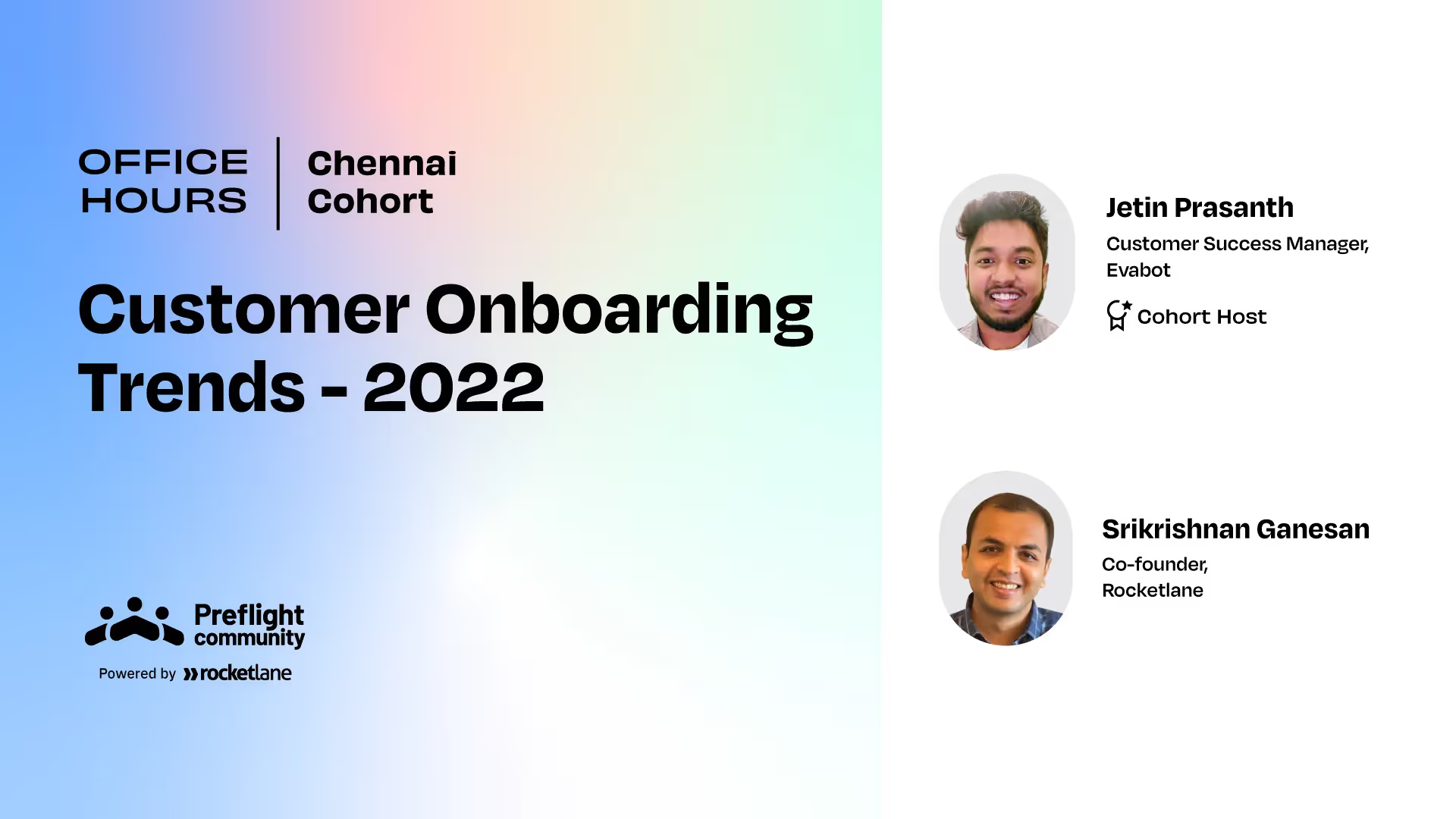In this session of Preflight's Chennai’s Office Hours, Jetin Prasanth, Chennai Cohort Lead and CSM at Evabot, spoke to Srikrishnan Ganesan, CEO & Co-founder of Rocketlane on the latest from the world of customer onboarding.
Srikrishnan shared his insights on:
- Emerging customer onboarding trends
- Key elements of customer onboarding
- Implementing customer onboarding: the when and the how
- Tools and tips for designing effective onboarding methodologies
Here are our top takeaways from the session.
Customer onboarding is finally getting the attention it deserves
The first sale is never the end of the engagement in the SaaS world. It’s the pathway to selling more. Building customer trust and confidence in your product and your team is crucial, and customer onboarding is your chance to do this. It is the first true partnership customers experience with you: it’s when they will assess you to see how proactive, efficient, and dependable you are.
Get customer onboarding right, and it improves opportunities to upsell, increases expansion potential, builds customer advocates, and ultimately, arrests churn. This explains why customer onboarding is the area of focus with experts consultations and more.
Four trends and developments in customer onboarding to watch out for
- Customer onboarding is now a priority: Considering that billing and renewals depend on adoption, companies have realized the downstream value that onboarding can unlock for them. They are beginning to think through and design their onboarding methodologies.
- Metrics and value delivery: Companies are beginning to have conversations around using onboarding to think about the value they can deliver in 30-60-90 days.
- Customer onboarding expertise: Today, there are organizations and experts dedicated to the field, with experts such as Donna Weber and Jeff Kushmerek helping companies set up and improve their customer onboarding methodologies.
- Dedicated teams/members for onboarding: Early-stage companies (Series A or seed stage) have begun to carve out roles mapped to onboarding. This way, they have separate teams and resources for onboarding while CS teams focus on renewals and managing churn.
Key elements of customer onboarding
Implementation is no longer equated to customer onboarding. It’s necessary but not sufficient.
In addition to the solutioning, customizing, migrating, etc., that implementation entailed, companies today need to consider training, customer education, and more.
They need to move beyond just enabling go-live to actively help customers realize value by understanding their goals, the jobs-to-be-done, and translating them into your product's usage.
This includes:
- Customer education and training that meets the customers where they are; a consultative approach, not just from a product perspective
- Documentation, not just about the product but also how the customer has been set up to use your product
- Identifying and managing risks
- Having a process for change management
- Configuration, integration, migration, etc. (duration and structure of onboarding)
Customer onboarding: When and how
It makes sense to have a dedicated resource if not a team when the customer onboarding process:
- Takes longer than two weeks
- Involves customizations (not self-serve)
- Serves more than five customers a month
The optimum model to work towards: Onboarding led by Professional Services and complemented by Customer Success.
For inspiration, check out Preflight Member Alex Farmer’s ‘road trip to business value’ analogy from his Implementation Stories session on the role of the CSM in customer onboarding.
Elements of the customer onboarding process and their focus areas
- Handoff: Focus on capturing and passing context. Pro tip: Involve onboarding/CS when you're 90% through the sale.
- Kickoff: Focus on making the best impression, showcasing the journey ahead, and building excitement and ownership within the customer team. Ensure that users are energized about the project and educated on what the project means for the company.
Pro tip: Get customer stakeholders to own key portions of this meeting.
- Solutioning: Focus on aligning the tech teams from both ends.
- Implementation: Focus on ensuring smooth account setup, configurations, integrations, and data migration. Pro tip: Invest time and resources in understanding the customer’s tech stack so you can enable your product to work well within the ecosystem. This is especially critical for enterprise customers who need your product to be customized to work with the rest of their tools.
- Testing/UAT: Focus on getting select employees from the customer side to test their use cases and sign off on the implementation before training other users.
- Training: Focus on training the wider team/end users to use your product in their context. Pro tip: Have a workshop around value delivery. Use this to help customers recognize the:
a) Tangible value being unlocked
b) Delivery of this value through your product
Customer onboarding: Do’s and Don’ts
Don’ts
- Don't be reactive: As the onboarding expert, take a proactive and prescriptive approach to every onboarding phase.
- Don’t rely on checklists: Checklists often ignore the sequential aspect of key tasks. So when you rely on a 10-point checklist for your customers, you run the risk of multiple tasks being partially completed. Instead, focus on developing your methodology to show customers a thought-through plan, highlight the resource and time commitments from their end, and minimize the tasks they need to focus on at a single point in time. For example, during Week 1, you could focus on data onboarding; in Week 2, you shift focus to integrations, etc.
Do’s
- Establish rules of engagement: At the kickoff stage, showcase what you'll do and when, how you will deal with missed deadlines from their end, and how you will handle escalations. Identify risks and communicate the de-risking options right at the start. This is critical to managing enterprise accounts.
- Have a communication plan: Agree on the channels you’ll use for engagement and the communication hierarchy (what information will go to key stakeholders and what will flow to end users, etc. )
- Ensure visibility: Show your customers exactly where they are on their onboarding journey at all times. Ensure that you’ve identified a stakeholder at their end who is updated on any delays/deviations at all times.
Best practices to handle typical SaaS customer onboarding challenges
Handling complex enterprise-level customer onboarding
In cases of POCs, scope the POC to push customers to narrow down the most important and indispensable use cases/functionalities. As the expert, you need to own and drive this conversation and show them what they need to assess what you can do for them.
For instance, if you're replacing a product, resist the temptation to take them exactly where they were with the earlier product. This means that you’ll need to focus on precisely what goals you want to help them with. You can also phase out your approach, say by staggering multiple processes such as tool changes, process changes, data migration, etc. Drive the project forward every quarter by running initiatives that help them get more value.
Handling churn
It helps to involve a team member from the solutioning or onboarding phase even before the sale is complete, say, at the 90% deal closure stage. This way, you’ll be able to have an honest conversation about what’s possible and what’s not; you can avoid any mismatched expectations that could lead to churn later.
Driving end user adoption
Develop a playbook for driving adoption. Initiate adoption with a subset of people from the customer team–ideally high-initiative employees with a growth mindset who can adopt and engage with your product first. Then, find the story that can resonate with the rest of the users.
Pro tip: Experiment with a ‘reverse demo’ where key users from the customer side demo exactly how they’re using your product to find value.
Four customer onboarding strategies for happy end users
Benchmarking Time-to-Value
One way to do this is by defining the first moment of value, getting the customer to agree on that goal, and then measuring how quickly you could get them there.
Handling issues arising from lapses at the customer’s end
Involve the executive sponsor. Show a commitment to course-correcting and fixing gaps, and align on a timeline when you want them to be ‘successful’.
Steering committee meetings can be an excellent forcing function to ensure that these things remain on track so you can meet the mutually agreed-upon deadlines.
A customer-centric framework for onboarding
Tools and systems
You should look to integrate at least four types of tools to assist in onboarding:
1. Customer education
You could use tools like Skilljar to offer self-paced learning (versus live training) for an effective and scalable approach to drive adoption. Make sure to push the right resources at the right time. For instance, you could stagger the training such that everyone on the customer’s team is expected to complete a particular module in a week, before the next meeting, or the next update.
2. Internal and external communication
Tools like Slack or Microsoft Teams are handy but fall short on visibility as updates and conversations are buried in chat conversations.
Rocketlane X Slack: Collaborate from the comfort of Slack
3. Project tracking and management
Onboarding needs a project tracking tool to handle project management internally and at the customer’s end.
4. Document collaboration
This could include tools like Notion or Google Docs to work on shared documents, templates, and more.
How Rocketlane can help
Rocketlane simplifies and consolidates communication, project management/tracking, and document collaboration with its unified workspace that improves communication, collaboration, and project visibility for teams and their customers.
Looking to see how you can benefit from a purpose-built customer onboarding platform? Sign up for a demo.
If you want to learn more about Customer Onboarding, Implementation, and Professional Services in-depth, join the Preflight Community.














